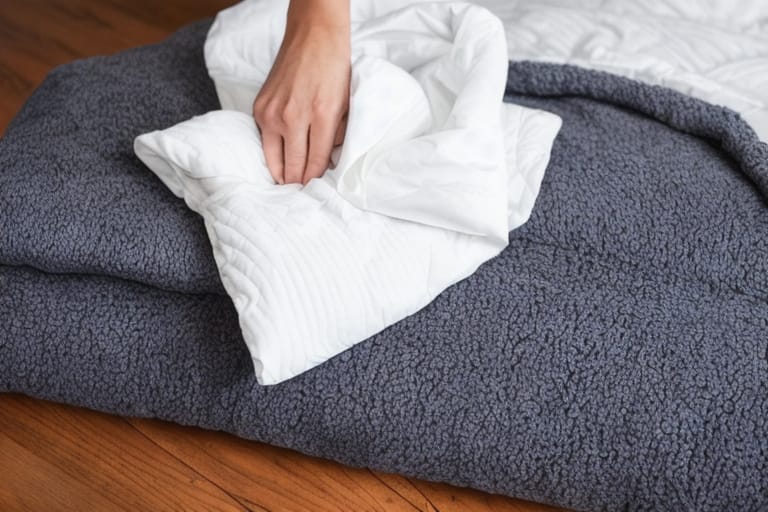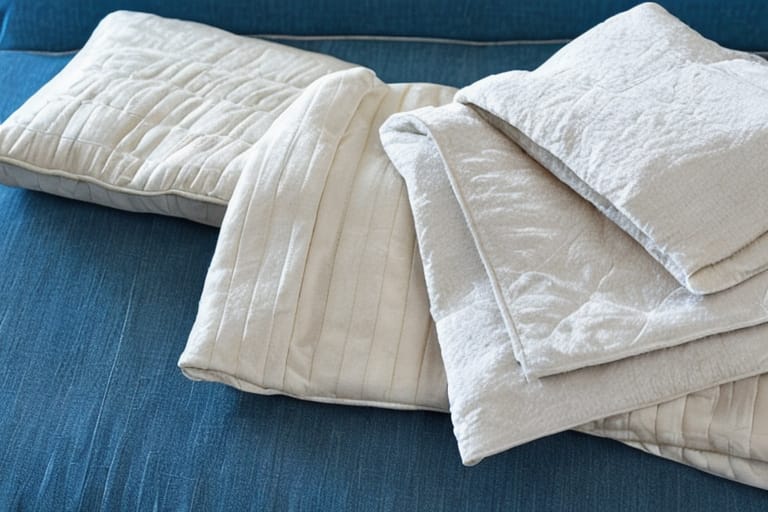When it comes to keeping your down comforter clean, dry cleaning is often considered the best and safest option. However, professional dry cleaning is not necessarily required to properly care for a down-filled bed cover. This comprehensive guide to down comforter care will give you all the information you need to decide if dry cleaning or at-home washing is best for your comforter.
What Is a Down Comforter and Why Does Cleaning Matter?
A down comforter is filled with the fine, fluffy under plumage from ducks, geese, and other waterfowl. These natural down feathers provide excellent insulation and loft that keeps you warm in bed. Unlike other comforters, down fill is very delicate and prone to damage from improper washing methods. This makes cleaning and maintenance important for comfort and longevity.
Knowing Your Comforter’s Cleaning Requirements
The best way to understand how to clean your down comforter is to check the care label. This will specify if your specific comforter can safely be washed at home or if dry cleaning only is required. Some common care label symbols you may see include:
- ⚠️ Dry clean only
- ✅ Machine wash, normal cycle
- 🚫 Do not wash
Certain types of down comforters, like those with baffle box stitching, may require professional dry cleaning. Understanding these specifications from the manufacturer is key.
The Pros and Cons of Dry Cleaning Down
Benefits
- Uses gentle solvents instead of harsh detergents
- Specialized equipment removes more soils
- Less risk of damage to delicate materials
Potential Drawbacks
- Exposure to chemicals used in dry cleaning
- Shrinkage or loss of loft over time
- Costly – From $50 to over $100 per treatment
So while dry cleaning may seem like the safest option, the chemicals involved could degrade your down over time. Home washing may be equally effective if done properly.
Step-By-Step Guide to Washing Down Comforters at Home
With the right tools and techniques, you can wash your down comforter at home safely. Here is an easy-to-follow guide:
Supplies Needed
- Front-loading washing machine (important for proper agitation)
- Mild liquid detergent or down-specific wash
- 2-3 wool dryer balls
Washing Instructions
- Check comforter care tag and confirm home washing is allowed
- Shake out comforter thoroughly outside
- Place in washing machine with dryer balls and detergent
- Select a delicate or bulky items cycle on cold
- Use low-speed spin cycle for extraction
Drying Tips
- Always air dry or tumble dry on low
- Add 2-3 new wool dryer balls to fluff fill
- Repeat air fluffing cycle every 20 mins until fully dry
This process allows thorough cleaning while protecting the integrity of the down fill. Refer to your care label to confirm this process is safe for your specific comforter.
Professional Down Comforter Cleaning Services
If you opt for professional laundering over dry cleaning, look for services that use specialized equipment and detergents formulated for down. Ask about their cleaning process to ensure:
- They fully wash and rinse all detergent residue from the down
- Use low temperatures and delicate dryer or air tumbler settings
- Add wool dryer balls to restore loft and avoid clumping
Expect to invest $25-$40 for a standard queen down comforter laundry service. Worthwhile for infrequent deeper cleaning.
How Often Should You Clean a Down Comforter?
Most manufacturers recommend washing down comforters once or twice per year depending on usage. However, more frequent cleaning may be needed if:
- You sweat excessively at night
- Have indoor pets that sleep in bed
- Notice visible stains from spills or bodily fluids
Use your nose too. If your bedding smells less than fresh, it’s time for a cleaning.
Storing Down Comforters Properly Between Cleanings
To prolong the lifespan of your down comforter, follow these tips when storing long-term:
✅ Use breathable cotton covers ❌ Avoid plastic storage containers or bags ✅ Store flat in cool, dry place ✅ Fluff and reshape before use
Proper storage allows the down fill to remain lofty and evenly distributed inside the comforter.

The Environmental Impact of Cleaning Methods
Both at-home and professional cleaning options for down comforters have environmental tradeoffs:
- Dry Cleaning: Harsh chemicals dispose as hazardous waste
- Home Washing: High water and energy consumption
Consider spot cleaning when possible or using professional services that prioritize sustainability.
Troubleshooting Common Down Comforter Issues
| Issue | Solution |
|---|---|
| Odors | Sprinkle with baking soda, set outdoors to air out |
| Clumping | Use dryer balls on air fluff cycle |
| Stains | Spot clean gently with upholstery foam cleaner |
| Tears | Repair by hand or professionally to avoid leakage |
Do not try to spot clean down with water only. Specialized products and methods are required.
Alternative Cleaning Options for Down
While machine washing or dry cleaning are most thorough, these more eco-friendly alternatives help lightly refresh in between:
- Steam cleaning – Use handheld low-moisture steamer on delicate setting
- Spot cleaning – Lightly dab soiled spots with microfiber cloth and gentle cleaner
- Natural deodorizing – Sprinkle baking soda then vacuum off; air out in sunlight
Understanding Down Comforter Construction
The performance and washability of a down comforter depends largely on how it is made. Key things to know:
- Fill power: Quality metric from 600-900+; Higher numbers mean more insulation
- Fabric shell: Cover materials like cotton or cotton-polyester blends
- Construction: Box-stitching helps down remain evenly distributed
- Thread count: Higher thread counts indicate more durable fabrics
Review all these factors plus the care instructions when buying a new down comforter.
Choosing the Best Detergent for Washing Down
Look for detergents free of dyes, brighteners and fragrances formulated for delicates or down:
- Eucalan Delicate Wash – Eco-friendly liquid made for fine fabrics
- Downlite Liquid Laundry Detergent – Highly rated premium down wash
- Seventh Generation Sensitive Skin – For those with allergies; fragrance-free
Avoid powder detergents as they may not rinse thoroughly from the down fill.
Caring for Down Over the Long Term
With proper maintenance, a quality down comforter can last over 10 years. Maximize longevity by:
- Using duvet covers for protection
- Alternating use between two comforters
- Washing before seasonal storage
This saves your existing comforter from excessive wear.
Allergy-Friendly Options for Sensitive Sleepers
For those with sensitivities, look for comforters advertised as:
- Hypoallergenic: Outer fabric woven tighter to avoid dust mites
- Allergy-Free: Special washes remove allergens from down fill
- Alternative-Fill: Primaloft or microfiber instead of natural feathers
Work closely with your doctor to manage environmental triggers.
The Bottom Line: To Dry Clean or Not?
While dry cleaning has long been the default recommendation, at-home washing is safe for most down comforters using the proper techniques. Refer to your care label, invest in the right equipment like a front-loading washing machine and dryer balls, and take time to properly air dry and fluff the down after cleaning. With a gentle process, you can keep your comforter fresh and save money versus expensive dry cleaning services.

Frequency Asked Questions
What happens if you wash a “dry clean only” down comforter?
Improper washing methods can strip the natural oils from down feathers causing them to clump together. This leads to bald spots with compromised warmth. Always verify that machine washing is safe for your specific comforter’s construction before attempting home laundering.
How do you maintain down comforters in hotels?
Hotels with down bedding should responsibly dry clean comforters every month of use and inspect carefully for any tears or visible stains. Spot cleaning treatments using professional products can also minimize the need for full laundering. Proper storage in breathable cotton bags helps preserve quality between cleanings.
Why does my down comforter get lumps after washing?
The delicate structure of down feather clusters can get disrupted during washing. Insufficient rinsing, too-harsh detergent, overload, or improper drying often contribute to this clumping effect. Use a mild down-specific detergent and add wool dryer balls on a no-heat tumble setting to restore loft and avoid lumps.
What is the best way to dry a large down comforter at home?
Tumble dry using the no-heat or air fluff cycle to completely dry all inner layers without risking damage from excess heat. Add 2-3 wool dryer balls to help separate and redistribute the down. You’ll likely need to run multiple 60-90 minute air fluff cycles, reshaking periodically. Then air out fully before using or storing.
Should I wash my down comforter after buying?
Yes, it’s advisable to launder a new down comforter before first use even if it looks clean. Production processes can leave behind residual dust, dirt or manufacturing oils that accumulate in the fill. Check the care label to see if machine washing is approved, and use cold water with mild detergent if so. Tumble dry with dryer balls on low.








